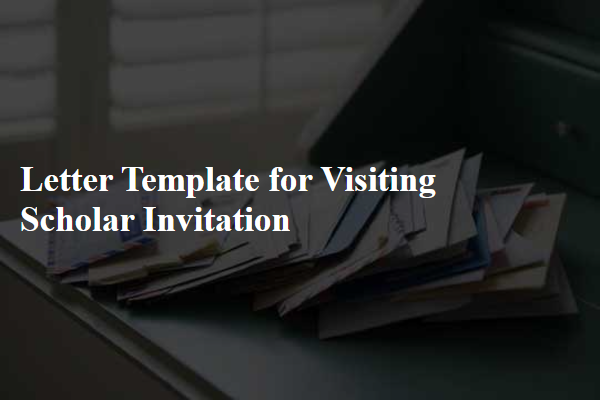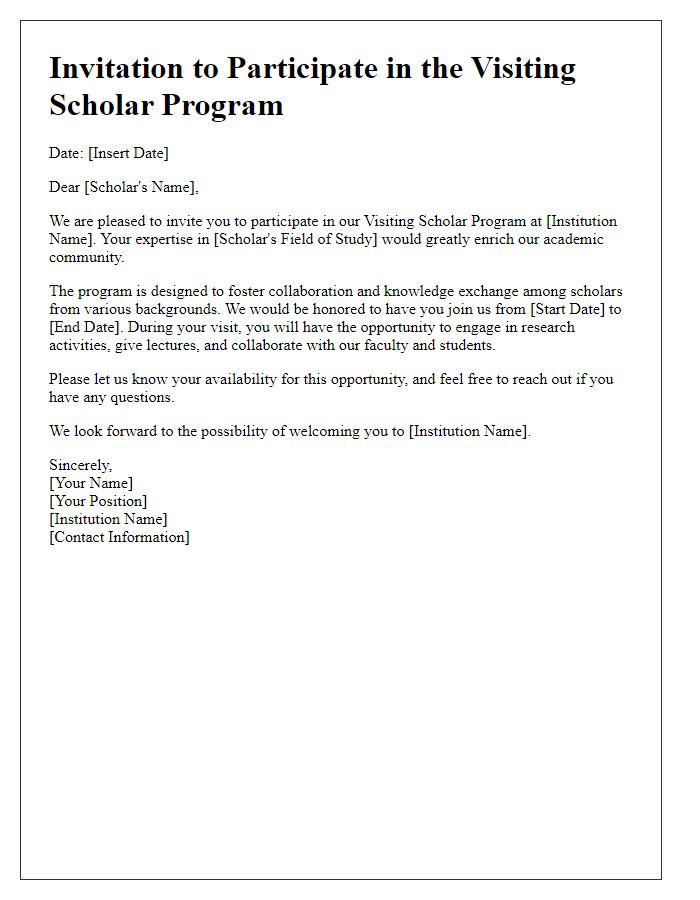Are you looking to broaden your academic horizons by inviting a visiting scholar to your institution? Crafting the perfect invitation letter can significantly enhance your chances of attracting top talent to collaborate and share knowledge. It's essential to convey not only the purpose of the visit but also the mutual benefits that such an engagement can foster. Dive into our article to discover effective templates and tips for writing a compelling visiting scholar invitation letter!

Purpose of Invitation
The purpose of the invitation for a visiting scholar is to foster collaborative research opportunities and enhance academic exchange between institutions. This initiative aims to bring distinguished scholars, renowned for their expertise in specific fields such as Social Sciences, Engineering, or Humanities, to engage with faculty and students at our institution. The visiting scholar will participate in lectures, seminars, and workshops (scheduled throughout the academic year) to share insights and findings from current research projects. The goal is to enrich our academic community, promote interdisciplinary dialogue, and potentially pave the way for future collaborative projects. Additionally, this visit supports the university's commitment to internationalization and enhancing its global academic presence.
Duration and Timeline
The visiting scholar program at esteemed institutions fosters academic collaboration and offers a structured timeline. Typically, the duration of the program ranges from six months to two years, accommodating various research projects and teaching engagements. Initial preparations commence with a formal invitation sent three months prior to the intended arrival date, outlining the scholar's focus area and objectives. Upon acceptance, a detailed timeline is established, including milestones such as orientation, project initiation, mid-term evaluations, and final presentations, all contributing to a robust academic exchange. Key events throughout this timeline may include workshops, seminars, and networking opportunities, enriching both the visiting scholar's experience and the host institution's academic community.
Financial Support and Resources
Visiting scholars often require financial support and resources to successfully engage in research at academic institutions. Funding sources for visiting scholars may include university grants, departmental budgets, and external fellowships. Resources such as access to research materials, laboratories, and administrative assistance can greatly enhance the research experience. Additionally, local housing options, transportation assistance, and networking opportunities can facilitate a smoother transition into the academic community. Universities located in major cities often provide greater access to diverse resources and research networks, which can significantly benefit visiting scholars during their tenure.
Institutional Affiliation and Facilities
An esteemed visiting scholar invitation often highlights the institutional affiliation and available facilities to foster research collaboration. The institution, such as Stanford University (established in 1885), provides access to extensive library resources, including over 9 million volumes and numerous academic journals. State-of-the-art laboratories equipped with advanced technology, like scanning electron microscopes and high-performance computing clusters, enhance experimental studies and data analysis. Additionally, collaborative spaces, such as innovation hubs or research centers, encourage interdisciplinary projects. Proximity to Silicon Valley enriches the visiting scholar's experience, offering networking opportunities with industry leaders and tech entrepreneurs. This comprehensive academic environment supports the scholar's research objectives, making it conducive for groundbreaking projects.
Expected Contributions and Outcomes
Inviting a visiting scholar enriches an academic environment through the introduction of diverse perspectives and expertise. Contributions may include research collaboration, innovative methodologies, and the development of interdisciplinary projects at institutions like Stanford University or Oxford University. These scholars often bring valuable insights from their home institutions, fostering discussions and workshops that stimulate intellectual engagement among faculty and students. Expected outcomes may encompass published papers, enhanced curriculum offerings, and the establishment of long-term partnerships across countries. Furthermore, hosting visiting scholars can elevate an institution's global reputation, attracting additional funding and collaborative opportunities for ongoing academic discourse and research initiatives.
Letter Template For Visiting Scholar Invitation Samples
Letter template of visiting scholar invitation for research partnership.

Letter template of application acceptance for a visiting scholar position.

Letter template of invitation for visiting scholar program participation.











Comments